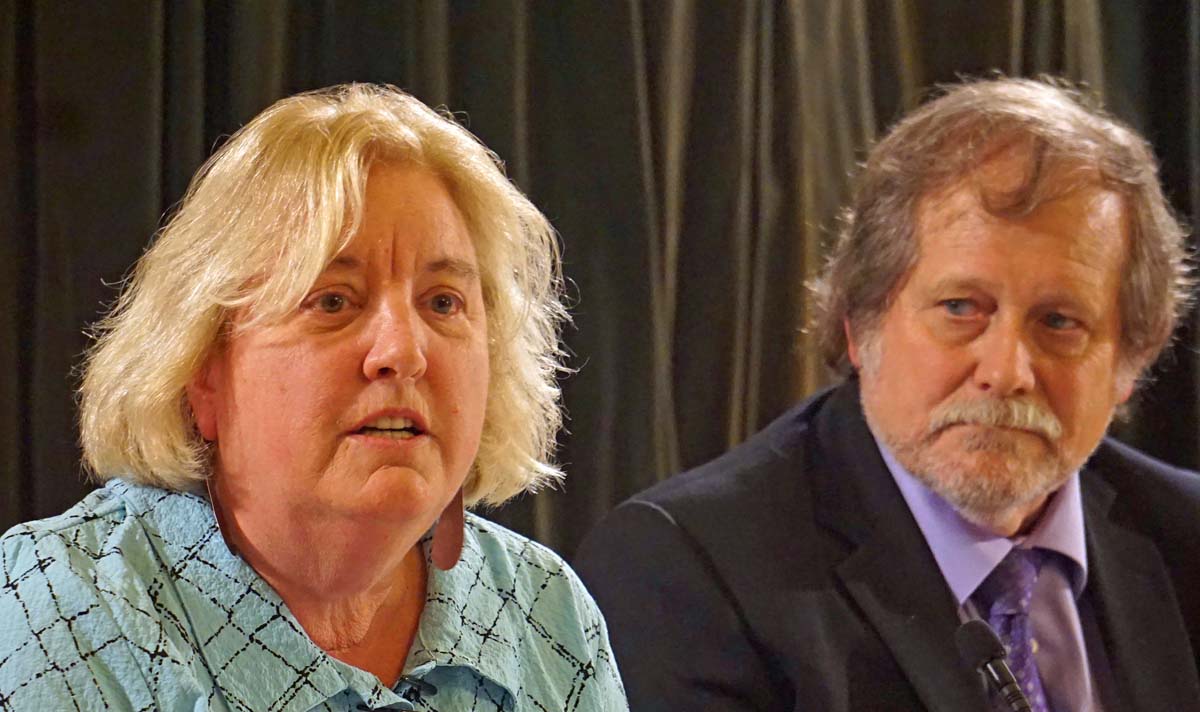Experts: Sustainable, Effective DD Systems Support Individuals; Don't Pigeonhole People In Groups
/Mary Lee Fay and William Ashe * All Photos By Anne Peters
By Gina Macris
When it comes to reforming service systems for those with developmental disabilities, policy makers often succumb to a fundamentally flawed approach, one expert told a Rhode Island Senate study commission Jan. 8.
Policy makers tend to “think about people in groups, but not think about people as people,” said William Ashe at a meeting of the commission, looking into how Rhode Island supports private service providers.
Ashe has helped the state of Vermont evolve toward a system that puts the needs of the individual first.
He also has become familiar with Rhode Island as a consultant to the federal court monitor overseeing implementation of a 2014 consent decree requiring the state to transform its segregated service model to a system that is integrated with the community.
Asked his opinion of Rhode Island system, Ashe said that what he’s seen leads him to believe it is a “barrier” to people’s ability to live more “independent and connected lives.” Ashe said his opinion is his own, not that of the monitor.
His comment,, however, happened to coincide with findings of the U.S. Department of Justice in 2014, which said Rhode Island’s funding rules incentivized segregation.
Ashe is executive director of Upper Valley Services, which serves a single county in Vermont that is about half the size of Rhode Island. He addressed the commission along with Mary Lee Fay, executive director of the National Association of State Directors of Developmental Disabilities Services (NASDDDS).
Fay presented a broad swath of statistics on nationwide trends, but she nevertheless arrived at basically the same place as Ashe, talking about building services around relationships between persons with disabilities, their families and other important people in their lives.
How To Apply Best Practices To Rhode Island?
The session raised questions about how members of the commission will process the information in coming weeks and apply it to Rhode Island.
For private providers, Rhode Island has a fee-for-service system authorizing payments to providers only three months at a time, for a fixed menu of supports, requiring documentation of each worker’s daytime interaction with each client in 15-minute increments.
There is also a parallel state-run system of group homes that is exempt from the rules applied to private providers, even though they are all paid through the federal-state Medicaid program.
With all its emphasis on making private providers accountable for each minute of service, Rhode Island’s funding model has no definition or measure of what the services are supposed to accomplish in terms of stabilizing or improving people’s lives.
Successful outcomes were a recurring theme among the best practices described by Ashe and Fay.
L to R: Commission Members Deb Kney, Kevin McHale, Tina SPears, and Chairman Louis DiPalma
After the meeting, the commission chairman, Sen. Louis DiPalma, D-Middletown, said the speakers offered a lot of “food for thought”. At the same time, he said, he wants to know more about the context of the successes in Vermont.
There, the predominant housing option is shared living in private homes – even for individuals who have challenging behavior - and services are tailored, or “bundled,” for a year’s time into individualized funding authorizations based on a person’s needs and goals.
Vermont’s system has been decades in the making, and DiPalma said he wants to know more about how the state got to where it is today. He said he expects commission members to begin airing their thoughts about the future of Rhode Island’s developmental disability system at the next meeting, yet to be scheduled, in late January.
Demographics, Economics Converge To Squeeze Human Services
Fay said that all the states are facing the same pressures, driven in part by the aging of the large population born after World War II.
Baby boomers have:
Increased the demand for the same type of direct care workers for the elderly as those who are employed in the field of developmental disabilities
Driven up the federal Medicaid and Medicare expenses, both entitlement programs with no cap.
Illustrating her point, Fay said that the fastest segment of the population is the elderly aged 85 and older. About 70 percent of that group needs some kind of assistance, she said.
Meanwhile, the expansion of Medicare and Medicaid, combined with last year’s tax cut, will lead to continuing debate in Congress about the future of these safety-net programs, Fay said.
At the same time, demographic projections point to a shortage of direct care workers. The group most likely to go into direct care work – women aged 18 to 55 – remains flat in demographic projections 20 years into the future.
Low wages are an issue with the current workforce, but Fay said the demographics indicate there just will not be enough workers to go around in the future. States “won’t be able to buy” their way out of the labor shortage, which will get much worse in the years to come, she said.
Instead, she said, states will have to “think” their way out of the crisis with a new approach; less reliance on 24-hour care and more supports built around families – and employment.
In Vermont, that approach seems to have paid off more often than not, according to Ashe.
Ashe’s agency is one of ten organizations in Vermont which have broad responsibilities within a designated area for serving adults with developmental disabilities, although there are several other specialized providers without geographic boundaries.
To receive immediate funding, individuals must meet high-priority standards as defined by law. They involve such factors as health and safety considerations or the need for care while both parents work outside the home.
In 2017, there were 238 people statewide on a waiting list for non-priority services, Ashe said.
Ashe’s agency, Upper Valley Services, covers Orange County, an area half the size of Rhode Island with a total population of 28,000, mostly spread out in towns and villages with populations of fewer than 1,500. There is one traffic light in the entire county, Ashe said.
Ashe said all service plans are individually designed and reviewed by a board which includes representatives of providers and consumers as well as state officials. The board’s recommendation is submitted to the state, which makes the final decision on services and funding.
Vermont and RI Differ on Funding Approaches, Wages
Vermont, like most other states, allocates funding on an annual basis. Rhode Island is the only state which funds services quarterly, Fay said.
And unlike Vermont, Rhode Island allocates funding first and expects providers to come up with an individual service plan that doesn’t exceed the budget.
Ashe credits the Vermont legislature for making a practice of anticipating an increasing caseload and funding to meet its needs, rather than forcing providers to dilute the supports for people they already serve to cover the new arrivals.
In 2017, Ashe said, 390 people benefited from the legislature’s new-caseload funding practice, he said.
Vermont’s designation of responsible agencies means they cannot reject anyone in their geographic area who meets the eligibility criteria for priority funding. As a one-stop shop for everyone, Ashe’s agency provides a broad range of services to about 200 individuals in its jurisdiction.
The starting wage at Upper Valley Services is $14 an hour and the annual turnover is 13 percent, significantly lower than the statewide turnover rate of about 23 to 25 percent. If Ashe must serve a particularly challenging client, he said, he has the authority to increase a worker’s hourly rate. Instead of $14, he said, he might pay $18.
Rhode Island providers pay an average entry wage of $11.36 an hour, according to a trade association, although some workers new on the job make minimum wage, which is $10.50 an hour. Job turnover in Rhode Island averages about 33 percent each year, although the rate varies among individual providers.
Nationwide, the average state-level rate of turnover is 46 percent, according to Fay.
In Vermont, the average cost of services per person is $60,037, Ashe said, slightly higher than in Rhode Island.
In a statewide population of just over 600,000, Vermont supports about 4,500 people with intellectual or developmental disabilities, about the same number as in Rhode Island, with a population of slightly more than one million.
Individuals have control over their service plans and may move money from one category to another, manage part or all of their services themselves, or let the agency be the service manager.
Employment And Housing
Among the clients of Upper Valley Services, 48 percent have jobs, averaging 8 hours a week, Ashe said.
Nationwide, the employment rate for adults with developmental disabilities is 19 percent, according to Ashe and Fay. Rhode Island’s rate is above the national average, but an exact figure was not immediately available.
Fay emphasized that employment is important not only for income, but also because a job provides autonomy and leads to connections with other people.
Shared living is one of five housing options in Vermont that, taken together, offer a broad range of supervision, up to and including intermediate care with a maximum of six residents in one facility.
The annual stipend for shared living is about $32,500. Ashe said he expects one responsible adult in the family to stay at home and not take an outside job.
Shared living should be viewed as part of a relationship, Fay said, not “foster care” or a “placement” that has nothing to do with the participants’ connections to each other.
24-Hour Case Management Key To Success
Ashe said the core of his operations is a network of case managers, each one with a caseload of about 14 people, who are on call 24 hours a day.
Case managers may arrange respite care for shared living providers or provide additional in-home supports, among a broad range of activities that include diffusing a crisis experienced by someone on their caseload.
In most instances, Ashe said, “the problem is not the person but the services around that person.”
His agency focuses on “re-building the support system to help that person stay in the community,” Ashe said.
In Vermont in 2017, there were five psychiatric admissions among adults with developmental disabilities, according to figures provided by Ashe.
Responding to a question from Rebecca Boss, Director of the Rhode Island Department of Behavioral Health Care, Developmental Disabilities and Hospitals, Ashe described the history of a crisis team begun in 1991 and crisis training for direct care staff in the field that has helped keep the number of psychiatric hospitalizations low.
Lending a national perspective, Fay said states are learning not to bring families to the table and expect them to speak a bureaucratic language to ask for a specific program, but instead to discuss ‘what is happening in your life and how can we support you?’’
Sometimes, families accept more services than they need, because they fear they will not be able to get them in the future, Fay said.
“I have visited states where people say, ‘I’ve taken a service not because I need it, but because if I say no, I’m afraid I won’t get access to anything in the future,’ “ Fay said.
States have to build trust in families, she said. Systems have to be designed to create an underlying confidence among families that the support will be there as the family’s needs change, she said.
Fay said “there isn’t a system out there that has it down perfectly,” but “states that do it well succeed because they have partnerships” with their communities.
To see an outline of Fay’s full presentation, click here.
To view a video of the commission meeting, click here. Look for an icon labeled with the date 1-8-19 and a title that reads “Special Legislative Study Commission To Evaluate Project Sustainability.” Note that some browsers may need Flash to play the video.








